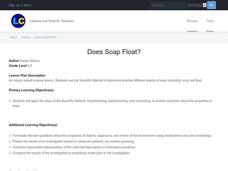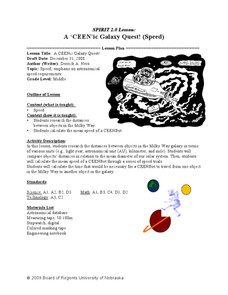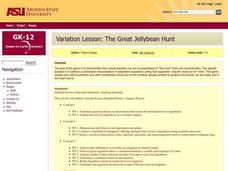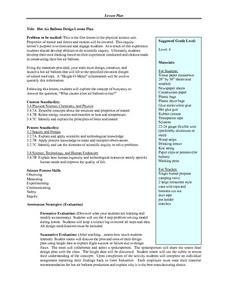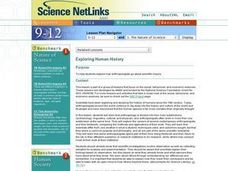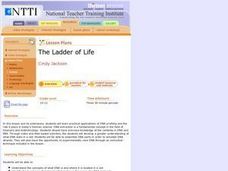Curated OER
Chain Reaction
Learners study animal behavior and how it changes to its environment. In this animal lesson students design and conduct experiments.
Curated OER
Natural Disasters
Students read the book "Tsunami!" and discuss natural disasters and how they can prepare. This lesson is much more than a study of tsunamis. The lesson is chock-full of ways to study the Japanese culture across the curriculum. There are...
Curated OER
Chameleons Are Cool!
Have your learners review what they know about camouflage using this lesson. Learners fill out a graphic organizer listing what they know or have questions about. This could be enhanced with the addition of a writing assignment in which...
Friends of Fort McHenry
Cannons During the War of 1812
During the Battle of Baltimore in the War of 1812, only 25% of the bombs and rockets fired at Fort McHenry actually reached their target. Using an interactive online simulation, combine your historical study with physics and discover why...
Curated OER
On the Microbe Trail: Bacteria and Aseptic Technique
Students pour, label, streak, seal and store plates in an incubator. They identify areas in their environment that provide a rich fauna of microbes once they have been swabbed. They identify areas of contamination through a laboratory...
Curated OER
Kites: Patang - The Indian Fighter Kite
Students investigate the history of fighter kites and build their own. In this aeronautics lesson, students discover how other countries utilize fighter kites and where they originated. Students create their own fighter kites in class...
Curated OER
Food Forensics: A Case of Mistaken Identity
High schoolers develop an experiment to test a hypothesis. They use their knowledge of antigen-antibody specificity to develop a hypothesis. Students articulate that the antibody-antigen specificity is one part of the immune system. They...
Curated OER
Floating Soap
Students use the Scientific Method steps to complete an experiment on various brands of soap to determine their floating capabilities. In this scientific method lesson, students write a hypothesis about the ability of various soap bars...
Curated OER
A CEENic Galaxy Quest!
Students research the distances between objects in the Milky Way. In this astronomy lesson, students calculate the time it would take for a robot to travel from Milky Way object to another. They create a travel package for customers...
Curated OER
Factors Affecting Microbial Growth
Students listen to a lecture on four factors that influence microbial growth and they discuss how to test the optimal growth requirements of a designated bacterium. They design and carry out laboratory investigations to test growth of...
Curated OER
The Great Jellybean Hunt
Students explore natural selection and its influence on the populations to fine tune traits and characteristics. The acquisition of traits developed out of need is examined through a game played in class.
Curated OER
School Lighting Audit Action Plan
Students write a school lighting audit action plan from the data they collected in previous lessons. They develop a presentation that shows the results of the data and their recommendations. They present their action plan to their...
Curated OER
Hot Air Balloon Design Lesson Plan
Sixth graders discuss what they know and what they want to know about hot air balloon using a KWL chart. They then use a wide array of materials to design a hot air balloon that will lift successfully in cooperative groups referring to...
Curated OER
School Lighting Audit Preparation
High schoolers work together to develop a school lighting audit plan. They practice using new vocabulary related to an energy audit. They also identify the components of a school lighting audit.
Curated OER
Layers of the Earth
Eighth graders study the earth's surface. In this planet structure lesson students view a PowerPoint presentation then draw and label the earths layers.
Curated OER
Exploring Human History
High schoolers study the four main subdivisions of anthropology and how they overlap. They explore the careers of several contemporary anthropologists and their fieldwork, comparing the methods and applications of their work.
Curated OER
The Wonderful World of Waves (Wave Basics)
High schoolers define amplitude, wavelength, frequency, and period, calculate period given frequency, and calculate frequency given period, define crest and trough and locate both on diagram of wave, differentiate between latitudinal and...
Curated OER
The Ladder of Life
Students explain the concepts of what DNA is and where it is located in a cell, identify the two types of molecules that make up the rungs of a DNA molecule and identify the two types of Purine and Pyrimidine molecules
Curated OER
You've Got to Be Cool to Make Igneous Rocks
Students describe how igneous rocks are formed, design a classification system to group igneous rocks and develop a controlled experiment to prove that the rate of cooling affects the size of the crystals.
Curated OER
Using Technology to Design Animal Habitats
Young scholars study the relationship between an animal and where it lives. In this habitats activity students research to obtain data and create a professional report.
Curated OER
Rocks and Minerals
Students are able to describe earth processes (e.g., rusting, weathering, erosion) that have affected selected physical features in students, neighborhoods. They are able to identify various earth structures (e.g., mountains, faults,...
Curated OER
The Colors of Seasons
Students observe each season and and mark the colors they see. In this colors of the seasons lessons, students read The Mystery of the Missing Hummingbirds and compare their results and note variations of colors in the different...
Curated OER
Design Your Own Rube Goldberg Machine
Students participate in a culminating activity for a unit on Energy and Simple Machines. They are challenged to incorporate simple machines in to a complex mechanical system. While designing and testing their machine they will also...
Curated OER
Invent on the Spot
The best inventions come from a problem that needs to be solved! Given a container with holes in it, learners must solve how to stop liquid from pouring out. They work together to develop an invention to accomplish this task.
Other popular searches
- Inquiry Based Science Lessons
- Inquiry Based Science Water
- Science Inquiry Based
- Inquiry Based Science Lessons
- Inquiry Based Science Sose
- Inquiry Based Science Souse
- Science Inquiry Based Learning









